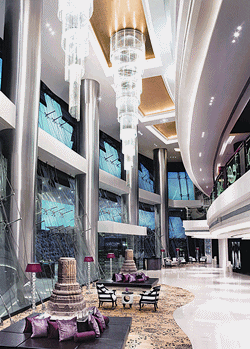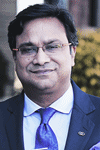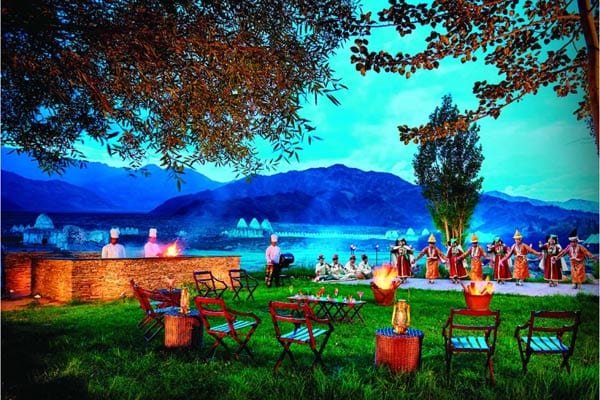The Luxe Experience
As India celebrates her 71st Independence Day, Express TravelWorld explores some of her unique bespoke luxury experiences that have great potential to attract the world traveller

From being a land of exotic palace hotels, which once defined the concept of luxury travel in India, today the luxury tourism offerings of the country have evolved along with the changing profile and demands of the new age international and domestic travellers. The changing definition of luxury has given a fillip to the luxury travel market in India, which has been growing at a robust rate, with great potential for the future. Luxury Travel Market report, published by Allied Market Research, forecasts that the global market is expected to generate US$ 1,154 billion by 2022. The APAC luxury travel market indicates the fastest growth on account of the growing number of middle income groups, with India estimated to register a CAGR of 12.3 per cent from 2016 to 2022. Pointing out that India is an emerging leader in the APAC market, Karan Anand, head – relationships, Cox & Kings, says, “India is known throughout the world for the huge spectrum of breathtaking experiences. Once only being a paradise for backpackers, India has evolved over a period of time to offer numerous luxury experiences within the country. The most exquisite luxury experiences include glamorous camping at TUTC Ladakh, the supreme comfort and luxury at a joyride on Deccan Odyssey, hot balloon ride over the pink city of Jaipur, spa in the tranquility of the Himalayas, houseboat tour to explore the backwaters of Kerala, relaxation at a private yacht in Goa and Ayurvedic treatments/ tree house stays in Kerala.”
The most common is of course an immemorial stay in one of India’s famed luxury palaces and resorts like the Taj Lake Palace (Udaipur), Umaid Bhawan Palace (Jodhpur), Laxmi Niwas Palace (Bikaner), Devi Garh (Udaipur) and Lebua Resort (Jaipur). Anand shares that Cox & Kings’ premium customers opt for the company’s exclusive Air Charter holidays to Kabini, Shillong and Rishikesh. There are also those who prefer only luxury vehicles. “We keep premium cars such as Mercedes, BMW, Audi and Land Rover at their service,” remarks Anand, adding that luxury travellers also ask for exclusive offerings such as seaplane flight, cruise along coast, desert camps and participation in local activities/ festivals. Culinary trails and private small-group journeys are also popular among this segment.

“Luxury is relative aspect,” asserts Vikram Madhok, MD, Abercrombie & Kent India, reminding that most luxury inbound travellers come to India for two things – first are the palaces and villas set in magical locations such as Udaipur, Jodhpur, the leopard camp in Jawai or Amanbagh at Alwar. “The second aspect of luxury is where it is experience based, whether it is going on the Ganges for spiritual experience or Varanasi or Rishikesh, or taking to the mountains and staying in remote areas discovering yourself,” mentions Madhok, adding that for his company the leading market is the US, followed by the UK and then come the rest. “You are looking at a price point from US$ 450-800 per night. As far as inbound is concerned India being a long haul destination, it demands more time, minimum two weeks, so we have seen those 60 and above are coming here. However, we have started to notice people are taking shorter holidays a year, maybe a spa vacation in the Himalayas or going for Ayurveda or Yoga to the backwaters of Kerala. This is from five to seven nights and preferred by younger people. Many of them have had a good experience in India and are coming back,” states Madhok.

The new age of luxury travel is curated, real-time and experience-led. “Luxury travellers primarily seek unique experiences that enrich them emotionally and psychologically. They do not mind splurging and opt for holidays which are intricately designed as per their requirements. They prefer to indulge while on a holiday,” says Amod Thatte, head – product, contracting and innovation, SOTC Travel, pointing out that Indian holidaymakers have taken a fancy to luxury holidays. They seek unique experiences (beyond regular sightseeing) and prefer their holidays to be of global standards from the beginning to the end. He remarks, “SOTC’s Luxury Travel Collection – Perfect Moments is an endeavour to keep innovating and expanding our destination markets creating perfect holiday moments for our customers. This collection has 9 glorious bouquets of luxurious holiday themes that cater and offer new and unique experiences that are beyond the expectations of a luxury traveller.”
Evolving demands

The changing demands of the new age luxury traveller is redefining the trends. “The new money millennials are ready to spend a bit more to get the right experience. I am seeing some extremely well established people from mid to late 60s who want to try the experiences, but do not want to pay for it, even though they have a lot more than the millennials. It is the mindset of the generation, and I wish that changes,” says Sushil Shamlal Wadhwa, founder and CMD, Platinum World Group, reminding that another trend that he is noticing is that lead times are getting shorter, whether it is MICE or luxury. Wellness, according to Wadhwa, is another major trend within India, with properties like Atmantan Wellness Centre near Pune and Carnoustie Ayurveda & Wellness Resort in Kerala making a mark. “In the luxury segment the Oberoi properties, Aman properties in Rajasthan and the boutique hotel Suryagarh near Jaisalmer give the quintessential Indian luxury experience,” adds Wadhwa.

Setting new trends are the millennials. Social media is a key driver in this space. Rajnish Sabharwal, COO, TUTC avers that tourism in India has evolved. “The new age domestic traveller does not just want to visit an Agra or a Jaipur but wants to know how different Agra is from Jaipur. The curiosity to see more, know more, and experience more is what drives the Indian domestic traveller today.” TUTC believes in bringing the beauty of unseen nature and many adventurous experiences on a luxury platform to fill in the need of discerning travellers. Each camp celebrates the indigenous culture and traditions, unique fairs and festivals. “Our Kohima Camp in Nagaland is planned around the Hornbill Festival, an annual melange of cultural displays from all 16 tribes of Nagaland, showcasing their rich heritage in this colourful pageant. The idea of glamping in the midst of tribal festivities is one of its kind in India and certainly piquing the interest of luxury travellers,” says Sabharwal.
 Luxury MICE is also contributing significantly to the growth. “Many destinations in India are offering unique offerings and projecting themselves as Luxury MICE destination to accommodate the growing demand for business meetings and social gatherings with an element of luxury,” states Sabharwal.
Luxury MICE is also contributing significantly to the growth. “Many destinations in India are offering unique offerings and projecting themselves as Luxury MICE destination to accommodate the growing demand for business meetings and social gatherings with an element of luxury,” states Sabharwal.
A matured traveller likes to have a mix of relaxation and exploration. “Destination selection plays an important role and depends upon many factors like the purpose of travel, the travel period (the weather has to be conducive for travel and outdoor activities). The demographics of the group also plays a very important role, for instance, if there are children involved then the sightseeing tours, activities have to appeal to them. Also, the accommodation needs to be chosen accordingly,” affirms Thatte, adding that family-owned properties, capitalising on the travellers’ desire to make deep, local connections, will become an even bigger draw in the upcoming years for the new age traveller.
Unique products
In the luxury tourism space the popular destinations for inbound travellers include the Golden Triangle and Kerala, along with Goa, Hampi, Rishikesh, Dharamshala and Khajuraho. “India offers a host of destinations that lend a sense of serenity and tranquillity. Our premium rejuvenation packages include authentic Ayurvedic treatments, spa and Yoga rejuvenation. Spiritual retreats at Waynad, Vythiti, Rishikesh and Jaipur are the most popular,” remarks Anand.

A few luxury getaways featured by experiential travel specialist, Wandertrails include Sarai Kothi in Kanha National Park offering jungle safaris, tribal village visits, nature walks and exotic bird watching. The luxury stays range from a century old Ladakhi home against the backdrop of the Himalayas in Leh to a heritage property in Goa and a homestay built on stilts in Coorg. “Spirituality, wellness and experiential – these three segments significantly comprise Indian travel. India has emerged as the world’s fastest growing wellness destination with an estimated projection of 17.2 million international tourists over the next 10 years,” states Narayana Menon, CMO and co-founder, Wandertrails.
Luxury hospitality

A significant aspect of India’s attraction is the unique hospitality options in luxury space – the forts and palaces. The recently opened Alila Fort Bishangarh offers its guests much more than a luxurious stay in magical settings. The all-suite resort boasts 59 stately suites that are designed for quiet indulgence. “In a region that boasts of palace hotels, Alila Fort Bishangarh is perhaps the first warrior fort restored into a luxury resort. With the growing trend of ‘Staycations’ and ‘Bleisure’ travel, guests are seeking a lot more than just stay with meals, such as opportunity to partake in unique activities, personalised services, memorable experiences with family and friends or visit to attend an annual event. At Alila Fort Bishangarh, we offer guests experiences unique to the culture and traditions of Rajasthan,” says Vijay Krishnan, GM, Alila Fort Bishangarh.
“With the concept of Alila Journeys, guests can choose from a variety of half-day or full-day excursions and activities that connect with local experiences,” states Krishnan. The experiences range from curated journeys to the local villages and enhance community engagement with the guests to a private wildlife safari through the Sariska Tiger Reserve and National Park to a scenic 50-minute helicopter tour offering spectacular 360-degree bird’s-eye views of the Fort and its surroundings. The property also offers five culinary experiences curated by celebrity Chef Ranveer Brar.

Bespoke dining experiences in fact form an integrtal part of luxury hospitality. Set amidst the exotic Himalayas, JW Marriott Mussoorie Walnut Grove Resort & Spa, offers its guests ‘Breakfast by the Stream’ in a forest hideaway where the Kempty Fall originates. “The breakfast table is set in the middle of the gushing water. Dip your toes in the chilly water; listen to the jungle waking up all around you while you dig into a lavish spread of a traditional Indian breakfast or a selection of the finest continental preparations,” says Ramandeep Marwah, GM, JW Marriott Mussoorie Walnut Grove Resort & Spa. Another unique experience is lunch/hi-tea at the farms, where you can dine in a rustic set-up with a table overlooking the spectacular Gharwal mountains. “The menu is especially handcrafted by the chefs, based on your suggestions, using the freshest ingredients that are grown right there on the farm. Complemented with international beverages and stunning scenery, this will be a lunch you will not easily forget,” mentions Marwah.
The property, with venues overlooking the Gharwal range of Himalayas, make the perfect setting for destination weddings. “Memorable weddings call for never heard of experiences for the guests. We offer bespoke meal options in the lap of nature to ensure guests leave enthralled. A specially crafted meal in iconic locations ensures a truly memorable wedding,” adds Marwah.

Luxury hospitality is also being redefined by a city hotels like the Sofitel Mumbai BKC which takes pride in being a unique address combining the best of warm Indian hospitality with French ‘art de vivre’ in a signature art nouveau style. “The expectation of guests today is for hotels to not only understand their needs and preferences, but anticipate them,” says Biswajit Chakraborty, GM, Sofitel Mumbai BKC, adding that from providing an iPod docking station to the best sleep experience with seven-layered bed called MyBed, to seamless Wi-Fi internet connectivity for multiple devices and an entire entertainment hub, the property presents the guest with the best that there is on offer. It also offers the 5-Senses Weekend Staycation Package for a much needed tranquil break.
The property has introduced a library in its business centre. “We are giving our guests the chance to relive the traditional aura with various genres on offer at our Business Centre Book Library,” states Chakraborty, adding that the recently opened art gallery at the hotel is a tribute to the brand pillars of culture and design. New and upcoming artists are given a chance to display their work and themed brunches are planned around their art.

Green initiatives is a focus for Sofitel Mumbai BKC, and despite being in the midst of a concrete grey jungle, the hotel has started planting its own herbs at its very own Herb and Kitchen Garden. “With the help of these herbs, we are not only committing to the environment but providing our guests with healthy and fresh produce,” informs Chakraborty. The property is known for its ‘Magnifique’ food festivals that promote the gastronomy and cultural aspect of the brand – from international chefs from countries like France, Germany, Japan, Vietnam to local chefs showcasing regional cuisine like Rajasthani, Bengali, etc.
Fillip to luxury tourism
There is a lot that needs to be done to promote India as a luxury tourism destination. The recent setback to luxury tourism/ hospitality has been the 28 per cent GST. “It is too high, it should have been in 18 per cent bracket. The destinations have suddenly become 10 per cent more expensive. In the long term it won’t be good for us. We are fiercely competitive as a destination and we should learn from New York City and Paris, where there is no 28 per cent GST tax on a hotel. High GST is a dampener for luxury travel,” says Madhok. He also believes that the government should make pockets of excellence in areas where currently people go. “They should not get overly ambitious with 60-70 circuits but fix the top 10 circuits where people come to India for, before they move to the next area,” he remarks.
Lack of good infrastructure remains a key handicap. Wadhwa believes that if rail transport/road transport, aviation and immigration, and tourism is integrated, India can be the biggest tourism revenue earner in the world in the next decade. “From Jailsalmer to the North East which has many beautiful destinations, however good infrastructure is seriously lacking. Bus stations, train stations should be upgraded aesthetically with dining, retail, clean rest rooms; also smaller airports at regional destinations where aircraft cannot fly should have heli-tourism. Vaishnodevi is a good example where heli-tourism is popular. It must be also made viable for hotel industry to open up hotels,” says Wadhwa, adding that there should be convention boards and tourism boards not just for the state, but also district/ cities, like many international destinations.
Inclusive growth of local communities through travel infrastructure development is integral. “The demand for luxury and experiential travel is increasing at a faster rate than what the services available are and the only way to encounter this is through enabling local stakeholders in the travel servicing process. From benefiting local businesses to popularising indigenous crafts, a complete alignment of customer satisfaction with community development is the best formula for equitable travel revenue benefit,” avers Menon.
“Apart from focusing on the infrastructure, which is the core of tourism development in India, concrete tourism campaign targeted at high-net worth tourists will also help to boost the growth of this segment,” asserts Anand, remarking that India also needs to focus more on attracting greater number of visitors from non-traditional destinations and demographics.

